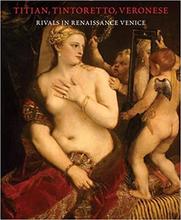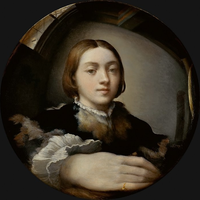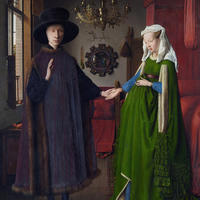More about Tintoretto
- All
- Info
- Shop

Sr. Contributor
If Tintoretto's life were a move, it would be called "The Fast and Il Furioso: Venetian Palette."
Tintoretto is a nickname-turned-pen name earned while working in his father's silk dying workshop. His real name was Jacopo Robusti. Jacopo's other nickname is Il Furioso, because he'd get into some weird, angry zone while killing it with the paintbrushes. His studio had the following inscribed in large print across one wall: "The drawing of Michelangelo and the color of Titian."
Titian was his master until the grumpy old goat kicked him out for being the fortunately unfortunate combination of insubordinate and too talented. Or, as another version of the same story goes, kindly ol' Titian kicked out Tintoretto because the wee lad already knew everything the teacher had to give. In any case, Tintoretto grew up to be kind of a homebody, and only left Venice once to make sure no one screwed up installing some of his work at the Ducal Palace in Mantua. Most of his time was spent painting and caring for his eight kids with his lovely wife.
Tintoretto was a shrewd businessman. Yay verily, the most hated on player-painter in Venice's crowded arts scene. Tintoretto would undercut everyone's prices. His shop may as well have been called Crazy Tito's Lo-Ball-Me Commissions. If he liked a project, he'd do it at cost for materials. If he really liked it (or, perhaps, wanted to circuitously ruin work for his competition) he'd do it for free.
Another thing that's totally Tintoretto was how quickly the ace Venetian could paint. It's all a part of that Il Furioso mentality. After thoughtful preparation, he'd go after the canvas and finish projects as quickly as possible. His process, which often left visible brushstrokes, was taken as either an expression of vitality or as poor technique. He also favored paintings with a lot of moving players in complex poses. One art historian phrased it that Tintoretto's figures are always "flying, falling, sinking, or biting." He'd construct stages with wax figures suspended by string to make sure the lighting and movement was just right. While he's certainly not the only artist to bring this particular crafting approach to their artistic method, Tintoretto did noticeably reuse the same figures over and again throughout his career.
He had a large workshop with assistants crawling about like the minions in "Despicable Me". Their workflow differed from the workshops of fellow Venetian titans (i.e. Titian and Veronese) in that he wanted assistants to do total remixes of his prior work. Artistic freedom aside, this is good for us because it makes determining which paintings are actually by Big Pimpin' relatively easy.

Contributor
If you’re looking for the fastest painter of the Renaissance period, look no further than Tintoretto.
Tintoretto was always too cool for school. He taught himself to paint, copying old masters to practice his brushwork. He may have outgrown his teachers, but the technique stuck around. If Titian’s confidence of color had a baby with Michelangelo’s precision of drawing, it would be Tintoretto’s work. It was his motto, and eventually his destiny. To remind himself of his goals, he wrote on his studio “il disegno di Michelangelo e il colorito di Tiziano" (the design of Michelangelo, the coloring of Titian). Those are very high standards, and also comes off as a little cheeky.
Sixteenth century Venice had three contenders for the best renaissance artists, Titian, Veronese, and Tintoretto. Interestingly, the doge preferred Tintoretto over the other two.
People called Tintoretto a lot of names. His father was in the dying business. He tinted clothes. So, little Jacopo started responding to Tintoretto. While he was young, another nickname caught on. Everyone was calling him Jacopo Robusti because his dad had very “robustly” defended the gates of Padua against the crown’s cronies and people admired him for it. Tintoretto’s real name, or the name given to him at birth, was Jacopo Comin. Comin is a local word for cumin. I wonder what's the story behind that. Did Tintoretto’s mother eat cumin, when he was conceived? Did his mum have cumin cravings when she was pregnant with him? Were his relatives spice merchants?
Tintoretto got another super cool nickname at work. His fellow artists were deeply impressed by the passion with which the Venetian master would paint. He would paint furiously. Il Furioso. A well-deserved name. Beats Comin any day.
Sources
- “Jacopo Tintoretto.” National Gallery of Art, n.d. https://www.nga.gov/collection/artist-info.1929.html.
- “Landmark Exhibit of Italian Renaissance Master Tintoretto to Open in U.S. Capital.” Xinhua, n.d. http://www.xinhuanet.com/english/2019-03/20/c_137910331.htm.
- Ilchman, Frederich. “The Triumph of Tintoretto.” Apollo Magazine, August 28, 2018. https://www.apollo-magazine.com/triumph-tintoretto-500/.
- Gould, John. Biographical Sketches of Eminent Artists. London: Effingham Wilson, 1834.
- “Tintoretto.” Wikipedia. Wikimedia Foundation, August 4, 2019. https://en.wikipedia.org/wiki/Tintoretto.
- The National Gallery, London. “Jacopo Tintoretto.” The National Gallery, n.d. https://www.nationalgallery.org.uk/artists/jacopo-tintoretto.
- Tremlett, Giles. “Tintoretto's First Show for 70 Years.” The Guardian. Guardian News and Media, January 29, 2007. https://www.theguardian.com/world/2007/jan/29/spain.artnews.
- Dunn, Daisy. “Tintoretto Unmasked.” The Spectator, September 12, 2018. https://www.spectator.co.uk/2018/09/tintoretto-unmasked/.
Featured Content
Here is what Wikipedia says about Tintoretto
Jacopo Robusti (late September or early October 1518 – 31 May 1594), best known as Tintoretto (/ˌtɪntəˈrɛtoʊ/ TIN-tə-RET-oh;
Italian: [tintoˈretto],
Venetian: [tiŋtoˈɾeto]), was an Italian Renaissance painter of the Venetian school. His contemporaries both admired and criticized the speed with which he painted, and the unprecedented boldness of his brushwork. For his phenomenal energy in painting he was termed il Furioso (Italian for 'the Furious'). His work is characterised by his muscular figures, dramatic gestures and bold use of perspective, in the Mannerist style.
Check out the full Wikipedia article about Tintoretto























